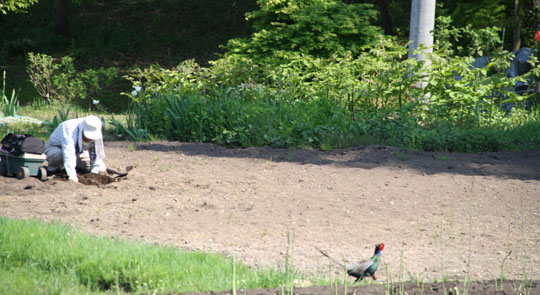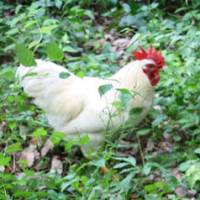Go wherever you will in the world but you'll never be far from a chicken.
Certainly, the only inhabited places on the planet where I haven't seen chickens running around somewhere have been in the Arctic. There were lots of ptarmigans there mind you, but no chickens (except for dismembered ones in the new supermarkets).
I was trekking in Nepal with a documentary team a couple of decades ago. We made camp close to a village and I was bored with dehydrated food so I went into the village, found an elder and asked if I could buy a chicken.
"Go ahead," he said. "Just catch it yourself."
Those Himalayan chickens were more than half wild. They were fleet of foot and could fly. After chasing around the village for half an hour, much to the amusement of the locals, I finally picked up a short stout stick and threw it at a cocky, multi-colored rooster perched in a tree. The missile flew with deadly accuracy and broke the rooster's neck. With nary a squawk he fell to the ground.
Spectators clapped and cheered as I retrieved the bird with a flourish and a gracious bow. Then I took it to the old fellow, the one who'd told me to catch my dinner myself, and asked how much he wanted for it. He shrugged and said, "I don't know, it's not mine."
Oh yes, that was a huge joke! With a following of giggling children I traipsed from house to house, apologizing, with the dead chicken dangling in my hand. I forget how much I eventually ended up paying for it, and don't even know if I got the right owner, but it made a fine curry that night.
I have been revisiting such fond memories since one early morning last month here at home in Kurohime, when I was roused from my slumber by a very loud and strident "cock-a-doodle-doo!" (Actually, being as this is Japan, it was more of a "koke-kokko!")
The damn bird went on crowing at full volume for several minutes. I was a tad perplexed because I haven't kept chickens for years, and none of my immediate neighbors here in the Nagano Prefecture hills keeps them either. I looked out of the bedroom window but could see no sign of the rooster, which seemed to be greeting the dawn from the woods across the road.
That evening, though, as it grew dark I looked out of my living-room window and saw a large white chicken stalking through the bushes. The next morning he started squawking like a bullhorn on full volume just outside my house. During the night he had taken up residence in the bushes beside the grassy patch between the trees that I call my lawn. The bird was still very cautious, almost elusive, but a couple of days later I got a better view of him and realized that he was accompanied by a pretty little pullet.
"Ah!" thought I, "this lusty rogue has eloped with the pretty little virgin; escaped the other clucking, fussing, nagging, demanding old hens!"
Mind you, it could have been that he was so noisy in the morning that his owner had dumped him, the way dogs and cats get chucked out, along with the young female to keep him company.
Ten days have passed since that first rude awakening and now the rooster and his companion have moved over to the Kobayashis' place next door. Perhaps he didn't appreciate my threatening language, although I didn't really mean it when I said I would rip his head off if he didn't shut up.
For a while I thought that the pullet had been snaffled by a cat, dog, fox or weasel, because she was nowhere to be found. The rooster had certainly fought with something, as there were a lot of white feathers on the ground under the dogwood tree beside my front steps. However, two days ago I saw them both, and while we were having lunch, I heard him crowing from the other side of the Kobayashis' place. I hope they survive.
The thought did pass through my head that I should catch and pen them, at least during the night, but the rooster proved to be a feisty, stroppy fellow, who probably appreciated his freedom. He even tried to attack me on my front steps when I went to give him some sweet corn. Whatever, I wish him and his pullet well.
This particular rooster is a fine white Leghorn with a splendid red comb and bright-yellow legs — a breed whose name comes from the English version of Livorno, a city in Tuscany, central Italy, from where it originates. Nowadays, Leghorns are probably the most commonly bred chickens worldwide as the hens are renowned layers. The little female is a Barred Plymouth Rock, a hardy breed from the United States that's commonly kept for both eggs and meat. She is attractively patterned, with small black and white stripes all over her body.
For a long time I believed that the ancestor of domestic chickens was a wild red jungle fowl from Southeast Asia, named Gallus gallus in Latin, that is a member of the Phasianidae (Pheasant) family. However, recent research has shown that chickens have also received genes from the grey jungle fowl, Gallus sonnerati, a native of India. Without doubt, though, their association with humans is so ancient as to date back into prehistory.
This fine white Leghorn rooster scared the little lad who comes to my house, the son of my housekeeper and general assistant. I hope the boy does not develop alektorophobia — a word I only recently learned which, unless somebody is pulling my leg, means "fear of chickens."
Though it's a long time since I last kept chickens, we are regularly visited by their wild cousins, the green pheasants known as kiji in Japanese. This is the national bird of Japan and for many years its image decorated the ¥10,000 notes before being replaced by some kind of symbolic thing that looks like nothing so much as an alarmed and wickedly violated mandarin duck.
Yesterday, when I went to gather cucumbers from the "tepee" on which I grow them in my garden, a flock of about 20 young pheasants flew up in alarm from the jungle of weeds that is supposed to be my vegetable patch. Maybe these two feral chickens should join the pheasants and really discover their inner wildness? Good luck to them.






















With your current subscription plan you can comment on stories. However, before writing your first comment, please create a display name in the Profile section of your subscriber account page.